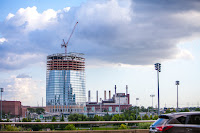Babel Rises Again
Babylon is called the “Land of Shinar” in Daniel, a link to the Tower of Babel incident in Genesis and the founding of the original imperial city in Mesopotamia. The same story is alluded to in Chapter 3 when the Babylonian king gathered all the nations of his realm to pay homage to the great and “high” golden image that he built in the “Plain of Dura.”
The Neo-Babylonian Empire was not a new political entity. It had an ancient pedigree, and in the New Testament, “Babylon” becomes the cipher for the latest incarnation of the World Empire, an entity that has appeared repeatedly on the Earth.
 |
| [Photo by James Lewis on Unsplash] |
In Genesis, God thwarted the completion of the high tower in the “Land of Shinar,” which caused the diversity and spread of languages and tribes across the region. That story provides the reader with the true origins of this history-spanning empire.
- (Daniel 1:1-2) – “In the third year of the reign of Jehoiakim king of Judah, came Nebuchadnezzar king of Babylon to Jerusalem, and laid siege against it; and the Lord gave into his hand Jehoiakim king of Judah and a part of the vessels of the house of God, and he brought them into the LAND OF SHINAR into the house of his gods, and the vessels brought he into the treasure-house of his gods.”
The opening paragraph builds on the story in Genesis, the time when the “whole earth was of one language and one speech.” The name ‘Shinar’ is the Hebrew equivalent of ‘Sumer,’ the first known civilization in Mesopotamia.
The people of Shinar built a city with a high tower “in the plain.” They intended it to “reach the heavens and thus make us a name, lest we be scattered across the whole earth.” This reflects the Sumerian culture where individual cities featured temples built on tiered mounds that formed the highest point of the city. Each was dedicated to the city’s chief deity, and each functioned as its civil, economic, and religious center.
God commanded Adam to “multiply, replenish and subdue the earth,” a command reiterated to Noah after the Great Flood. However, humanity chose instead to move to Mesopotamia and build a new civilization, thereby making a name for itself. Throughout the Bible, Babylon is characterized by arrogance and self-worship - (Genesis 1:28, 9:1, Isaiah 14:13-14, 63:12-14, Jeremiah 32:20).
If humanity united under one language, the wickedness of men would know no boundaries. By confounding their language, God caused the nations to spread throughout the Earth, and He stopped the first attempt to establish a centralized State. The idolatrous ambitions of Babel were delayed for a time, though under King Nebuchadnezzar Shinar began to rise once more.
Hence, the king of the latest incarnation of “Babel” attempted to reverse God’s ancient judgment. Having conquered Judah, Nebuchadnezzar set out to gather different ethnic groups to his city to be educated in the “language of Babylon,” and to honor his idolatrous “great golden image.”
PARALLELS
Like the story in Genesis, Nebuchadnezzar gathered captives in Babylon, the great city that HE BUILT. Under his direction, the different tribes and peoples of his dominion would learn the “LANGUAGE OF THE CHALDEANS.” What the inhabitants of ancient Babel began to do, Nebuchadnezzar attempted to complete.
The King also “SET UP” a great golden image of exceptional “HEIGHT” in the “PLAIN of Dura,” then decreed that “ALL PEOPLES, RACES, AND TONGUES” must render homage to it. He gathered representatives from every province and nation “to the dedication of the image.” The whole Earth was summoned to one place to render homage to Nebuchadnezzar’s “HIGH” golden image - (Daniel 3:1-8).
The verbal parallels are deliberate. Just as the earlier inhabitants of Mesopotamia united to build a city and high tower to honor and glorify their “name,” so the later king(s) of Babylon presumed to gather all humanity under his sovereignty.
In Revelation, “Babylon” becomes a cosmic entity that wages war against the “Lamb” and his people, the World City contrasted with the “City of New Jerusalem.” She is the “Great Whore” full of “abominations” and every “unclean thing.” Her hands are stained with the “blood of the prophets and saints that have been slain on the earth.” She is characterized by her cruelty, arrogance, and self-worship – (Revelation 17:1-6, 18:24).
Her influence and mischief impact the entire Earth, not just Mesopotamia or the Near East. The key to her power is the control of global commerce, and economic sanctions are her weapon of choice – (Revelation 18:1-24).
 |
| [Photo by Yohan Marion on Unsplash] |
This Babylonian entity spans History. She rides the “Beast from the Sea” that has “Seven Heads and Ten Horns,” the monster that has “ascended from the Sea” repeatedly over the centuries.
Its “Seven Heads” represent seven kingdoms or empires. Five had fallen by the time John received his vision. One existed in his day, and the seventh and final incarnation was yet to come. “Babylon” has been an ever-present reality throughout human history – (Revelation 17:7-12).
Likewise, today we see “Babel” rising again, another imperial power ascending from the “Sea.” Even now, she is imposing economic control over nations, spreading her corruption across the Earth, and suppressing groups and individuals that refuse to pay the “Beast” and its “great image” the homage both she and the “Beast” she rides demand.
RELATED POSTS:
- Babylon Then and Now - (The story of Ancient Babylon’s demise is reflected in the Sixth Trumpet and the Sixth Bowl of Wrath in the Book of Revelation)
- Theology of History - (Imperial hubris is the legacy of the Tower of Babel, humanity’s first but certainly not attempt to establish the World Empire)
- Babylon Rides the Beast - (Babylon has ridden the Beast from the Sea and its Seven Heads and Ten Horns since the Tower of Babel – Revelation 17:7-13)


Comments
Post a Comment